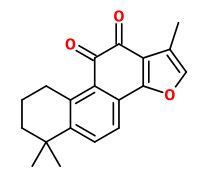Dies ist eine alte Version des Dokuments!
Salvia miltiorrhiza Bunge - Lamiaceae - 丹參 dānshēn (chin.), red sage, Chinese sage, Rotwurzel-Salbei
Perennial herb, up to 80cm tall, native to Northeastern China, Manchuria, Japan; taproot thickened, succulent, scarlet outside; leaves simple to odd-pinnate, leaflets circular to broadly lanceolate; flowers white to mauve or violet.
var.miltiorrhiza: Leaves odd-pinnately compound; leaflets ovate or elliptic-ovate to broadly lanceolate. Used medicinally for coronary diseases.
var. charbonnelii: Leaves simple, sometimes 3-foliolate; blades or leaflets orbicular to suborbicular.
http://www.efloras.org/florataxon.aspx?flora_id=2&taxon_id=200020230
„Salvia miltiorrhiza (alone or combined with other Chinese herb medicine) was applied to the treatment of variety of diseases such as angina pectoris, myocardial infarction, hypertension, hyperlipidemia, and acute ischemic stroke.“ https://en.wikipedia.org/wiki/Salvia_miltiorrhiza
„Experimental studies have shown that DanShen dilated coronary arteries, increased coronary blood flow, and scavenged free radicals in ischemic diseases, so that it reduced the cellular damage from ischemia and improved heart functions. Clinical trials also indicated that DanShen was an effective medicine for angina pectoris, MI [myocardial infarct], and stroke.“
[Salvia miltiorrhiza and ischemic diseases., Ji, X.Y., Tan, B.K., Zhu, Y.Z., Acta Pharmacologica Sinica, 21(12), 2000, 1089-1094]
Tanshinone IIA from Salvia miltiorrhiza „ …markedly inhibited the production of NO, IL-1beta and TNF-alpha, and suppressed the expression of iNOS in a dose-dependent manner. These results suggest that the traditional use of S. miltiorrhiza as an anti-inflammatory herbal medicine may be explained, in part, by the inhibition of NO, IL-1beta, IL-6 and TNF-alpha production, and expression of iNOS.“
[Tanshinone IIA from Salvia miltiorrhiza inhibits inducible nitric oxide synthase expression and production of TNF-alpha, IL-1beta and IL-6 in activated RAW 264.7 cells., Jang, S.I., Jeong, S.I., Kim, K.J., Kim, H.J., Yu, H.H., Park, R., You, Y.O., Planta medica, 69(11), 2003, 1057-1059]
 tanshinone IIA
tanshinone IIA  15,16-dihydrotanshinone I
15,16-dihydrotanshinone I
A dichloromethane extract of Salvia miltiorrhiza showed a pronounced inhibitory effect on recombinant monoamine oxidase A (MAO A) and on inducible NO synthase (iNOS) induction. Four tanshinone-type diterpenoids (tanshinone IIA, 15,16-dihydrotanshinone I, cryptotanshinone and tanshinone I) were isolated. „The IC50 of the most active compound, 15,16-dihydrotanshinone I, on human recombinant MAO A was at 23mM, and 2.4mM on lipopolysaccharide-mediated iNOS induction in Raw 267.4 cells.“ In the MAO A and iNOS assays, tanshinone IIA was the least active compound.
[HPLC-based activity profiling of Salvia miltiorrhiza for MAO A and iNOS inhibitory activities., Dittmann, K., Gerhauser, C., Klimo, K., Hamburger, M., Planta medica, 70, 2004, 909-913] https://www.dkfz.de/en/tox/download/gerh/pdf-files/Planta_Medica_70_909-913_2004.pdf
„Salvia miltiorrhiza (SM) BUNGE or Danshen, used in treatment of various systemic and surgical infections in the hospitals of China, was able to block the lethal toxicity of LPS in mice via suppression of TNF-α release and protection on liver injury. The ability of SM to suppress LPS-induced TNF-α release is further confirmed by in vitro experiments conducted on human peripheral blood leukocytes (PBL) and the RAW 264.7 macrophage cell line… The present study explains some known biological activities of SM, and supports the clinical application of SM in the prevention of inflammatory diseases induced by Gram-negative bacteria.“
[Protection of lethal toxicity of endotoxin by Salvia miltiorrhiza BUNGE is via reduction in tumor necrosis factor alpha release and liver injury., Wan, J.M.F., Sit, W.H., Lee, C.L., Fu, K.H.M., Chan, D.K.O., International immunopharmacology, 6(5), 2006, 750-758]
„Danshen (Radix Salviae Miltiorrhizae, SM) is a popular traditional Chinese herb widely used in treating cardiovascular, renal, and hepatic diseases by improving circulation and resolving stasis. Salvianolic acid B (Sal B), also known as lithospermates B or tanshinoate B, is a major water soluble component extracted from SM, which was well recognized as an antioxidative agent and free radical scavenger, involved in the protection of various cells, including nerve cells and hepatocytes. It was reported that SM and its aqueous extract, Sal B, produced a good effect in treating patients and animals with chronic renal diseases… Sal B can prevent tubular EMT [epithelial-to-mesenchymal transition] in the fibrotic kidney… the mechanism of Sal B is closely related to the regulation of TGF-β1/Smads pathway, manifested as the inhibition of TGF-β1 expression, suppression of TβR-I expression and function, down-regulation of Smad2/3 phosphorylation, and restoration of the down-regulation of Smad7, as well as inhibition of MMP-2 activity.“
[Salvianolic acid B prevents epithelial-to-mesenchymal transition through the TGF-β1 signal transduction pathway in vivo and in vitro., Wang, Q.L., Tao, Y.Y., Yuan, J.L., Shen, L., Liu, C.H., BMC cell biology, 11(1), 2010, 31] https://www.ncbi.nlm.nih.gov/pmc/articles/PMC2874764/
Tanshinone IIA was identified as a natural Monoacylglycerol lipase (MAGL) inhibitor in a concentration dependent manner (IC50 = 48 μM). „Considering being used as long-term treatment of cardiovascular diseases in China, tanshinone IIA has the potential to be developed as a good candidate for the treatment of Alzheimer's disease and other MAGL-associated diseases.“
[Identification of tanshinone IIA as a natural monoacylglycerol lipase inhibitor by combined in silico and in vitro approach., Yang, R., Lu, Y., Liu, J., MedChemComm, 5(10), 2014, 1528-1532]
